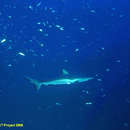Brief Summary
provided by EOL authors
Requiem sharks - the Carcharhinids - are distributed throughout temperate and tropical oceans with several species occurring worldwide. Habitats are oceanic beyond the continental shelf (oceanic whitetip sharks, Carcharhinus longimanus) and inland into freshwater rivers and lakes (bull sharks, Carcharhinus leucas). Some species tend to associate with bottom while others range throughout the water column. All carcharhinids are viviparous or ovoviviparous (Compagno, 1984). Carcharhinid sharks are a valuable resource worldwide. They are utilized for their flesh, fins, oil, and skin, and are taken recreationally (Bonfil, 1994). Some species are known to travel long distances, occasionally crossing oceans, and are considered to be a resource shared between regions and nations. Carcharhinidae genera can be difficult to identify due to similar body shape, color, and overlapping distributions; particularly Carcharhinus species and Rhizoprionodon species. There are a number of shark identification keys and field guides that are invaluable for carcharhinid identifications and those works are fundamental for providing a format for accurate identifications (Bigelow and Schroeder, 1948; Baughman and Springer, 1950; Springer, 1950; Casey, 1964; Clark and von Schmidt, 1965; Schwartz and Burgess, 1975; Hoese and Moore, 1977; Boschung, 1979; Garrick, 1982, 1985; Castro, 1983; Compagno, 1984; Gar man, 1997; McEachran and Fechhelm, 1998). Members of Carcharhinidae are variously distinguished by the presence of precaudal pits; lack of spiracles (present on tiger sharks and occurring rarely on lemon sharks, Compagno, 1988); bladelike teeth with single cusps; first dorsal fin origin usually above pectoral fin or slightly posterior to pectoral fin inner corner (except on the blue shark with the dorsal fin base midpoint closer to pelvic fin origin than pectoral fin axil); second dorsal fin smaller than first dorsal fin and above anal fin (second dorsal fin and first dorsal fin almost equal size on lemon sharks); fifth gill slit over or posterior to pectoral fin origin; no fleshy keels along sides of caudal peduncle (except on tiger sharks and blue sharks); well developed nictitating membrane along eye socket lower margin.

